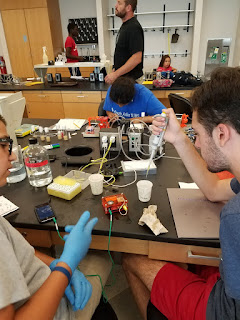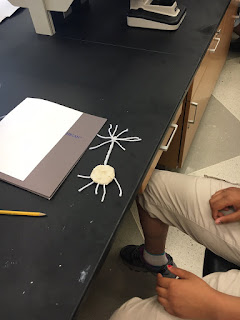Monday we started with a good foundation of learning about the brain. We learned about what a neuron is and the parts of the brain. We looked at slides of mammal neuron cells and then made models of our own neurons. We then dissected a sheep brain to learn about the parts of a neuron. We had a visit from Dr. Orie Shafer (but you can call him Orie) at the University to give us an introduction to neurons. It is his NSF grant that made this camp possible.
 |
| Two neurons communicating at a synapse. |




We did a nerve conduction speed test, but grabbing rulers that were being dropped by a partner. The measurements were recorded and we calculated the average to determine the reaction time.
We then tried an experiment using the Backyard Brains EMG Muscle Spiker Box to record the electrical activity of their muscles.
We also went on a Campus Tour in the afternoon and learned a lot about the University of Michigan Campus.
 On Tuesday, we talked about the Scientific Process. We learned that the Scientific Process is closer to what scientists do in real life. Instead of having the steps in a straight progression (like the Scientific Method) this shows a cycle.
Scientists work in cycles like this. When they finish an experiment, they look
at what they’ve just learned to design their next experiment. If they didn’t
get the results they expected, they change their experiment, or their
hypothesis, to find out what went wrong.
On Tuesday, we talked about the Scientific Process. We learned that the Scientific Process is closer to what scientists do in real life. Instead of having the steps in a straight progression (like the Scientific Method) this shows a cycle.
Scientists work in cycles like this. When they finish an experiment, they look
at what they’ve just learned to design their next experiment. If they didn’t
get the results they expected, they change their experiment, or their
hypothesis, to find out what went wrong. |
| Removing the cockroach leg |
We then worked with cockroaches and to learn more about neurons. We removed the cockroach's back leg, by anesthetizing it in ice water first. We attached it to this special device called a Neuron Spikerbox from Backyard Brains. We could then listen to the neurons in the cockroach leg. We then stimulated the barbs on the cockroach leg and could view the spikes. We applied pressure and also used a straw to blow air on the leg.
 |
| Applying pressure to the cockroach leg |
respond.
We then stimulated the cockroach's leg muscles using the music on our phones.
 |
| Making the cockroach leg dance! |

We then were able to go to the Taubman Health Sciences Library to visit the Anatomage Table to learn more about the brain and nervous system. The Anatomage Table is the most technologically advanced anatomy visualization system for anatomy education.

 On Wednesday, the campers experiments moved to humans, and the campers got to conduct experiments on one another! Orie introduced the circadian clock and asked campers if he thought their reaction time would be different at different times during the day. We had the campers make a hypothesis and then test it. We used special equipment that we hooked up to their muscles and when a light was flashed they flexed those muscles. The special equipment would then record that information. We could look and measure their reaction time. We had campers test it out several times throughout the day to see if their reaction time was different. We learned that most had better reaction time in the afternoon.
On Wednesday, the campers experiments moved to humans, and the campers got to conduct experiments on one another! Orie introduced the circadian clock and asked campers if he thought their reaction time would be different at different times during the day. We had the campers make a hypothesis and then test it. We used special equipment that we hooked up to their muscles and when a light was flashed they flexed those muscles. The special equipment would then record that information. We could look and measure their reaction time. We had campers test it out several times throughout the day to see if their reaction time was different. We learned that most had better reaction time in the afternoon.We also learned how to "take someone's free will". We learned how to use your muscle signal to control other devices, in this case, a TENS (transcutaneous electrical nerve simulator) to excite and contract the muscle of another human!
In the afternoon we went on a tour of Orie's lab, which was really cool!
 |
| One of Orie's lab staff talking to campers |
 |
| Orie talking to campers |




 |
| Looking at flies under the microscope |

First we learned how knock the fruit flies out using CO2 gas. We then sorted the fruit flies by males and females. Then we practiced attaching them to coverslips so we could use a special apparatus called the Optostimmer (which Orie helped design with Backyard Brains) to look at them. We had two different groups of flies and we wanted to see which group would stick their tongues out when a light was flashed.
 |
| Using light to stimulate the fly |

On our final day of camp, the campers took a trip to the Nichols Arboretum to examine smells and how our brains process them. At the end of the day, the campers got to conduct their own experiments using the equipment we have been using all week. Campers came up with questions, formed a hypothesis, and made predictions about what would happen if they did certain things. After gathering data, campers presented their findings to the class. We had a great week at Neuroscience Camp this week! And a big THANK YOU to Orie for making this camp possible and helping out this week!


 |




No comments:
Post a Comment